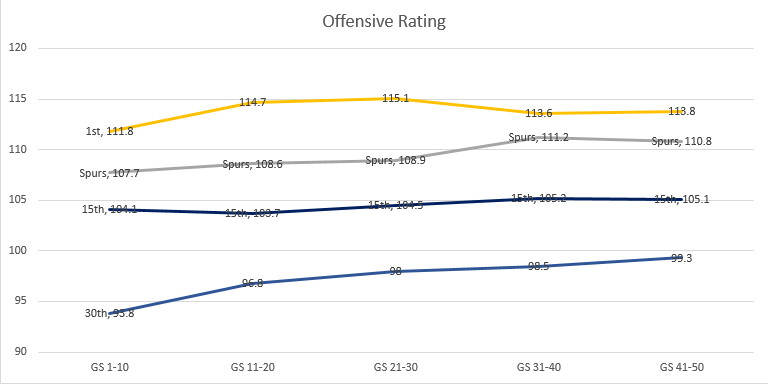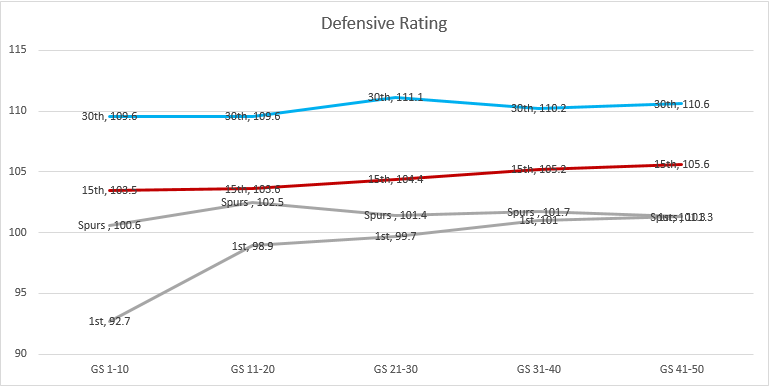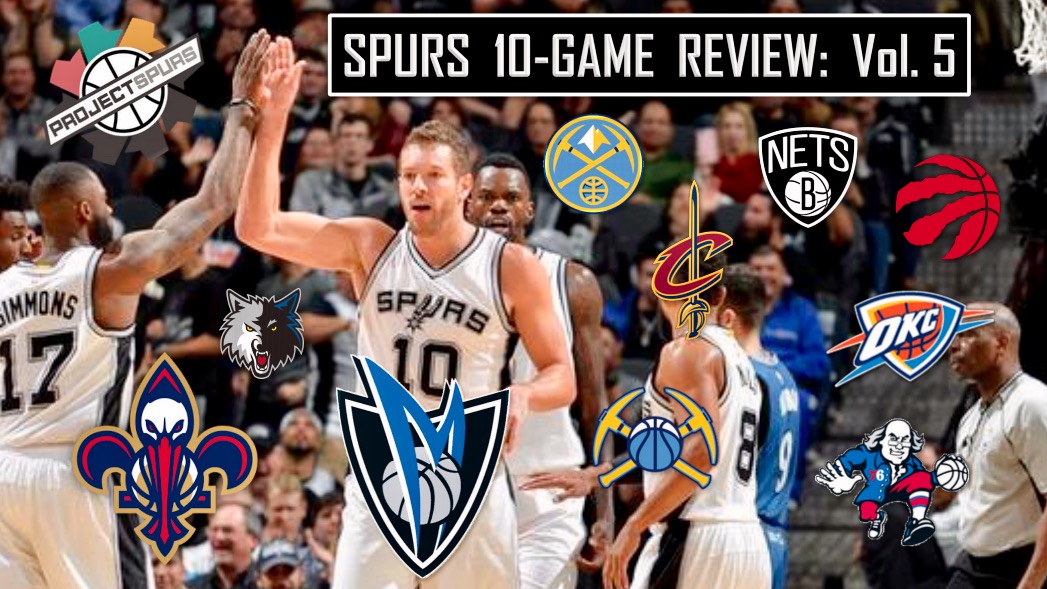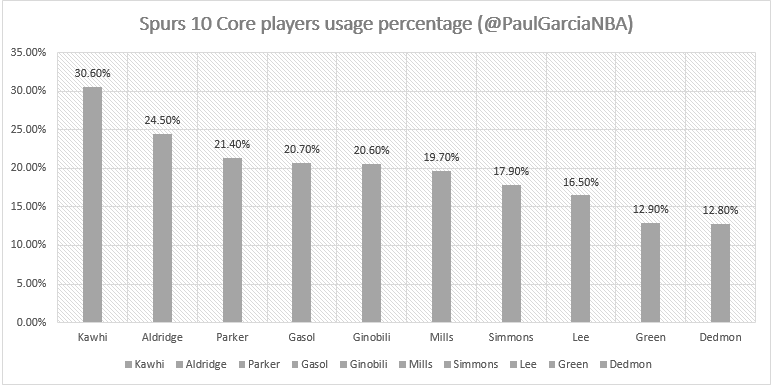With 50 games under their belt, the San Antonio Spurs are on pace to finish with the second best record in the NBA, as they’re currently 39-11. Despite facing multiple minor injuries and one major injury, the Spurs still managed to go 8-2 in their last 10 games. The team lost center Pau Gasol to a broken finger injury, while Kawhi Leonard, Tony Parker and Jonathon Simmons all missed over two games during the Spurs’ last 10 games.
With different rotations being used nightly, the Spurs managed to fall two times in a row to teams below .500, but they did get a marquee win on the road against the Cleveland Cavaliers, along with a few blow outs along the way. As has been done after every 10 games this season, here’s an assessment of how the Spurs are performing on both ends of the floor as a whole through 50 games.
Section I. Scoring

While the Spurs are still ranked 4th offensively, the Gasol injury has brought their offensive efficiency down a bit. Denver Nuggets Head Coach Mike Malone pointed out that since Gasol’s injury, the Spurs have been playing at a faster pace.
“Since Pau Gasol has been out, they’re playing a bit faster,” said Malone Saturday before facing the Spurs. “They’re probably ranked about 8th in pace in play since he’s been out, so you can’t beat yourself against that team.”
After nine games without Gasol, Malone is right, as the Spurs have increased their tempo from 96.98 Possessions Per 48 minutes (25th) this season to 101.32 Pp/48 (6th) without Gasol in the last nine games. During that stretch, the Spurs have seen a jump in scoring, as they’re putting 110.1 points per game on the scoreboard compared to their season average of 107.6 PPG.
However, without Gasol, the team hasn’t been as efficient as they are with him in the lineup. For the season, the Spurs score 110.8 Pp/100 each night, with most of that collected data having Gasol on the floor. Since he’s been out, San Antonio has only been scoring 107.9 Pp/100, which is giving them an average offense (13th) during the last nine games. You see it too in the efficiency shooting percentages. For the season as a whole, the Spurs have an effective field goal percentage of 53.4%, ranked 4th in the NBA. Minus Gasol in the last nine games, San Antonio only has an effective field goal percentage of 51.8%, which is a ranking of 18th during that stretch.
One player who the Spurs have had to rely on heavily over their last 10 games is Kawhi Leonard. In the last 10 games he’s played in, Leonard has averaged 29.9 points in 33.9 minutes per game. When looking at the leading scorers in the NBA over their last 10 games, Leonard is tied at third with James Harden (29.9 PPG) and he’s only behind Russell Westbrook (31.6 PPG) and Isaiah Thomas (35.2 PPG) for the leading scorer spot during that timeframe.
With Gasol being out, the Spurs have also had to rely on David Lee, Dewayne Dedmon and Davis Bertans to play by LaMarcus Aldridge’ side. So far, the trio have done their part, as they’ve all seen an increase in minutes and thus, their production has increased both in scoring and in grabbing rebounds.
Lee’s production for the season: 7.2 points, 5.5 rebounds in 18.6 minutes.
Lee’s production in the last nine games: 10.8 points, 8.2 rebounds in 25.8 minutes.
Dedmon’s production for the season: 5.0 points, 5.8 rebounds in 15.9 minutes.
Dedmon’s production in the last nine games: 6.0 points, 5.9 rebounds in 16.9 minutes.
Bertans’ production for the season: 4.3 points, 1.4 rebounds in 11.5 minutes.
Bertans’ production in the last nine games: 8.9 points, 2.8 rebounds in 19.0 minutes.
With only four bigs available, the Spurs also signed Joel Anthony to two 10-day contracts, where he’s had to play in five games.
While the Spurs’ frontcourt is still surviving minus Gasol and the team is still winning games without him, the team does need him, especially offensively, to go from an average to Top-5 caliber offense.
Where do the Spurs’ points come from?

The Spurs have seen a slight uptick in their percentage of points that are coming from the paint. Part of this is due to the Gasol injury. With Gasol off the floor, the Spurs are getting more of their scoring from frontcourt players like Lee and Dedmon, who both mostly get their points from the paint or free throw line.
Using the NBA’s Usage Percentages for players, I created the chart below to show the Spurs’ 10 core players and how much of the team’s possessions they’ve been using when on the floor.
Let’s spend a few words on one of Danny Green’s underrated additions to his game – his playmaking ability. As you can see from the chart above, Green doesn’t get many opportunities to create for himself or others, as he’s the team’s 9th playmaker when looking at the 10 players with core minutes and roles. However, when you really dig into the numbers and watch the game tape, you’ll discover that even though Green doesn’t get to have the ball in his hands much during the course of a game, he’s turning into a pretty decent dribble penetration piece for the Spurs’ offensive attack.
First, let’s discuss Green’s playmaking ability through his passing. Green is currently averaging 1.9 assists per game, which is the most for him since 2015, when he averaged 2.0 assists that season. Teams know Green is a dangerous outside shooter (40.2% from 3-point range), so their goal is to try to run him off the 3-point line each time. Green has developed decent dribble penetration skills, as he’ll see the close out coming and quickly shift his body to drive in. Green is able to drive in, read the floor, and either pass to a cutter toward the rim or shooter in the mid-range area. It’s not always just on close-out situations either, as Green is getting more comfortable running the pick-and-roll or driving in on a fast break opportunity, then kicking out. The video below is proof:
[protected-iframe id=”51084258a27331f341ac73c30d503e1e-114320562-25928832″ info=”http://streamable.com/e/7rv08″ style=”position:relative”]Now let’s talk about Green’s scoring ability when he penetrates the defense. In 42 games, Green is averaging 7.5 points per game. Here’s something to consider regarding his points – with all the weapons San Antonio has on offense, Green is shooting his least amount of shots per game (6.3) ever in a full season with the Spurs. But, as mentioned above, he’s still dangerous from three if left open and he’s started to attack the rim a bit more on close-outs, especially with the development of his floater to get the ball over opposing bigs.
[protected-iframe id=”e20421a7e4c9690f341df1eb4eb74839-114320562-25928832″ info=”http://streamable.com/e/vbuin” style=”position:relative”]In the restricted area, Green is currently shooting 55%, which is just 1.5% below league average. When you consider he’s only taken 40 shots in that area, that’s not too bad for a guy who is barely attacking the rim close to 1.0 times per game. And you have to remember, it’s not like the Spurs are purposely calling Green to run pick-and-rolls like they do with Parker, Leonard, Mills, Ginobili or Simmons; most of Green attacks are coming either late in the shot clock or off close outs.
While Green is still considered one of the best ‘3-and-D’ players in the NBA, defenses can’t think that’s his whole game, as he’s now more comfortable attacking the defense off the dribble, as the evidence above shows.
Where do the Spurs rank in Offense thus far?

Best: Golden State Warriors – 113.8 Pp/100
Spurs: 110.8 Pp/100 – 3rd
League Average: Indiana Pacers – 105.1 Pp/100
Worst: Philadelphia 76ers – 99.3
Section II. Ball Movement

Despite 55.1% of their playmaking coming from Leonard and Aldridge, the Spurs are still able to zip passes all over the floor either out of dribble drive action, or out of the post. One of the ways passing multiple times in a possession is tracked is through the use of the ‘hockey’ or secondary assist. As the data shows, after 47 games, the Spurs remain third in secondary assists per game, as they’re averaging 6.6 per game on their 24.2 assists per game. For those that aren’t familiar, the secondary assist is measured by Player A passing the ball to Player B, then Player B passes the ball to Player C, and Player C makes the shot. In order for the assist to count as a secondary assist, Player B has to move the ball after catching it from Player A within two seconds and with less than one dribble. Here are a few examples of the Spurs executing the secondary assist lately.
[protected-iframe id=”3db7e194f92881341f4e88feb1456e7c-114320562-25928832″ info=”http://streamable.com/e/otr0a” style=”position:relative”]Section III. Defense

Since the Gasol injury, opposing teams have been putting more pressure on the rim, as they’re attacking the restricted area 31.0 times per game (ranked 3rd) in the Spurs’ last nine games. With players like Aldridge and Dedmon occupying the paint, they’re still altering shots, as teams are only converting 57.3% of those attempts in the restricted area (Spurs’ defense ranks 4th in defending shots in restricted area) during that stretch.
When going back and reviewing some film, it’s noticeable that with the faster pace in play without Gasol, the Spurs’ defense is more susceptible to giving away easy looks in the paint. When the Spurs go down on offense and take a quick shot – make or miss, the defense has a better chance to push the tempo on the other end before the Spurs’ halfcourt defense is set. This allows opposing offenses to get more breakdowns against the Spurs’ defense and a chance at uncontested dunks or layups on occasion. Part of this also has to do with the fluctuating lineups the Spurs were using during the last 10 games, which in turn led to more situations of miscommunication on defense because of the lack of experience spent together for various lineups.
When the Spurs are healthy and only missing Gasol, they’ve shown they can clamp down on defense for a decent 6-12-minute stretch. Overall, over their last nine games without Gasol, the Spurs have held teams to 98.5 Pp/100 on defense, which is ranked first during that stretch and 2.8 Pp/100 below their league leading defensive average. So, while one might argue they’re better defensively without Gasol on the floor, it’s still just a nine-game sample size and it’s only 2.8 Pp/100 than having a 100% team on the floor. The dimension Gasol brings is still a defense that’s ranked first overall, but as mentioned above, he also brings their offense to a Top-5 level.
As Spurs Head Coach Gregg Popovich mentioned recently, Gasol could be making his return either right before or just after the All-Star break.
Where do the Spurs rank in Defense thus far?

Best: San Antonio Spurs – 101.3 Pp/100
Spurs: 101.3 Pp/100 – 1st
League Average: Cleveland Cavaliers – 105.6 Pp/100
Worst: Denver Nuggets 110.6 Pp/100
Section IV. Record Vs. Elite teams (.600 Winning Percentage)
| Category | Currently |
| Winning Percentage | 69% |
| Record | 9-4 |
The Spurs are currently 9-4 against teams with records of .600 or above.
Golden State Warriors: 1-0
Los Angeles Clippers: 0-2
Houston Rockets: 2-1
Cleveland Cavaliers: 1-0
Boston Celtics: 2-0
Utah Jazz: 1-1
Washington Wizards: 2-0
Total: 9-4
Section V. The Next 10
The Spurs’ next 10 games will come during the course of their annual Rodeo Road Trip. They’ll play 9 of their next 10 games on the road, but they’ll only see one team with a record above .600 (Clippers), and just three teams with records above .500 (Grizzlies, Pacers twice) during that stretch. The Spurs’ six other opponents during their next 10 games all currently have records below .500.
Data gathered from NBA.com/stats as of 02/04/2017 at 11:59 PM CST. Bench stats collected from HoopsStats.com after 49 games for San Antonio. Passing stats collected after 47 games.
Add The Sports Daily to your Google News Feed!

